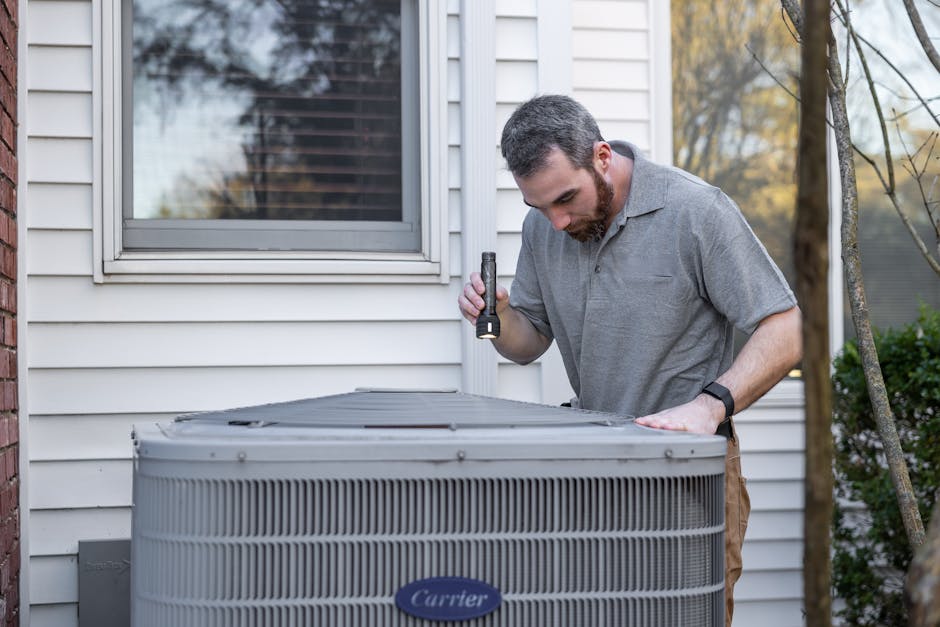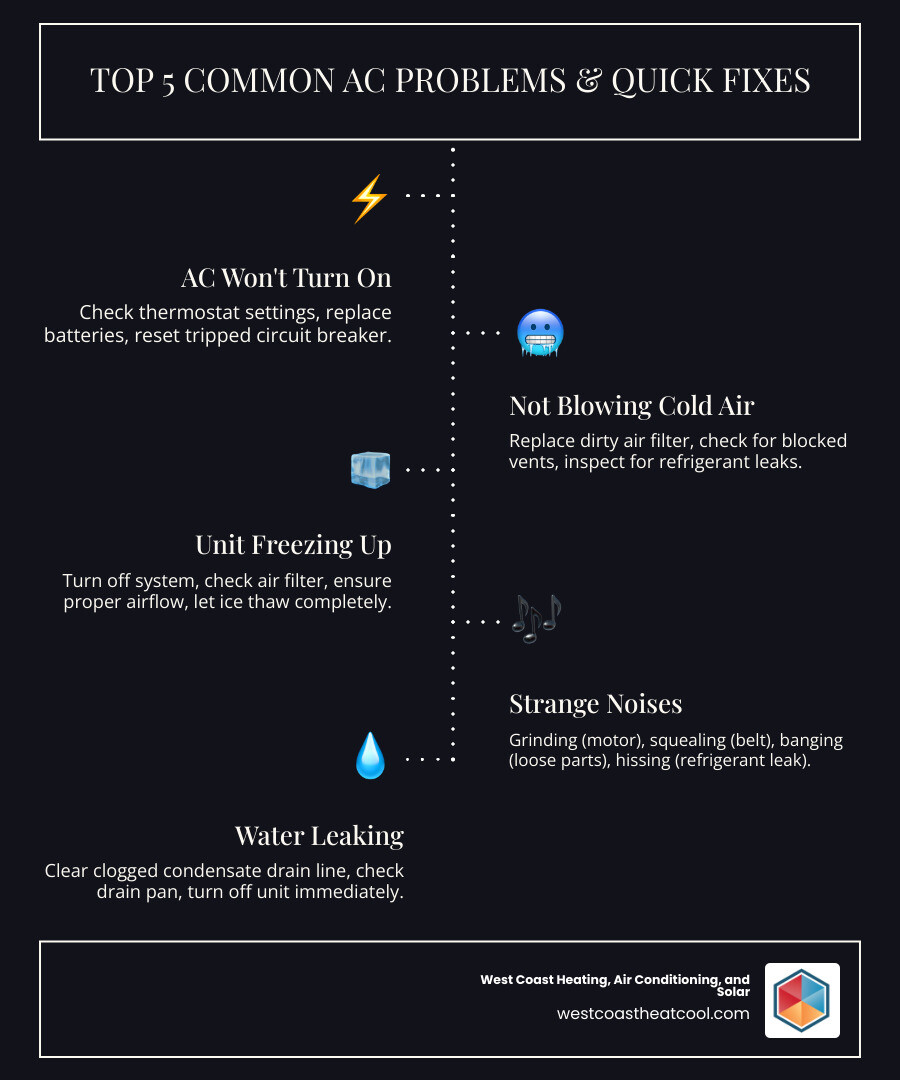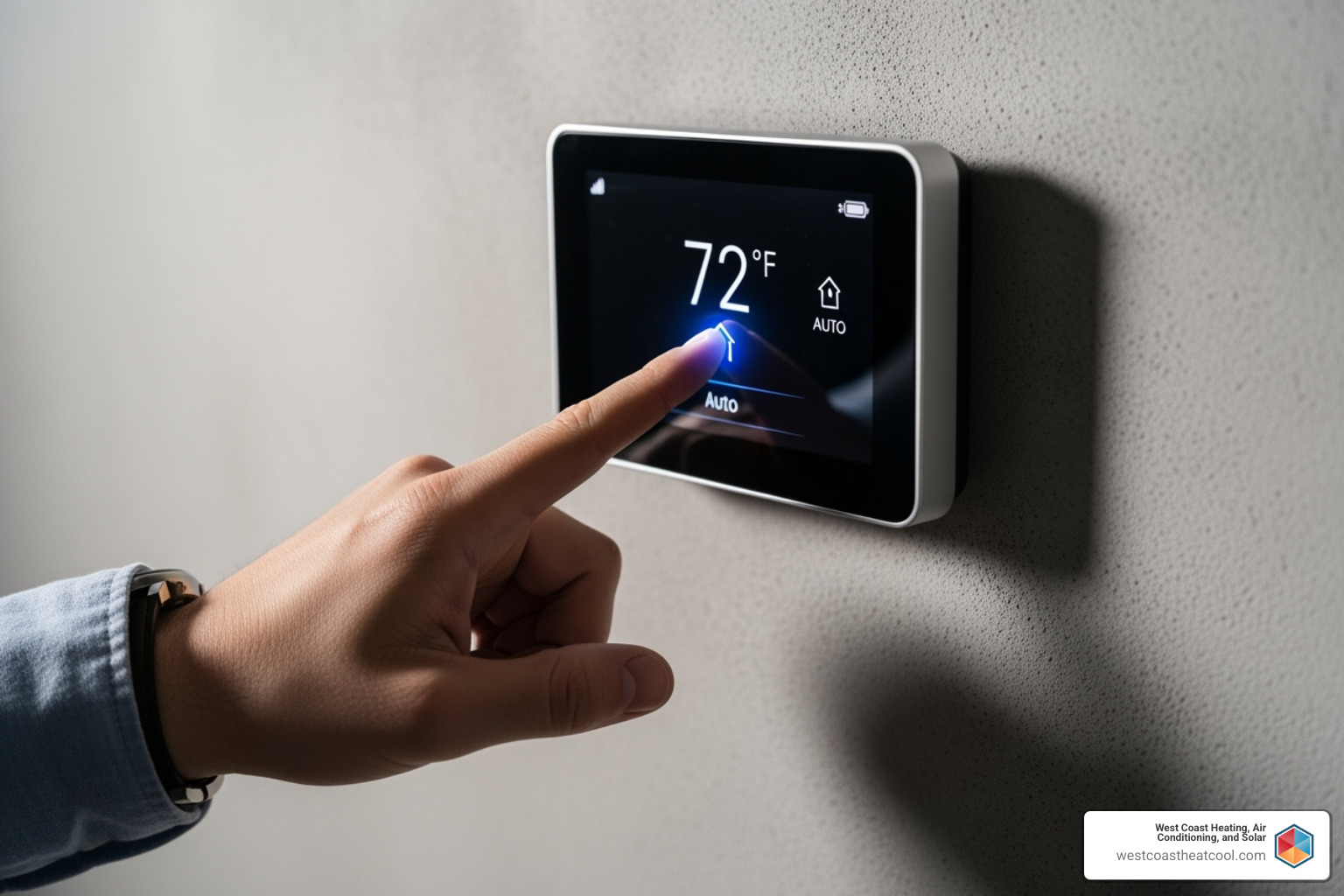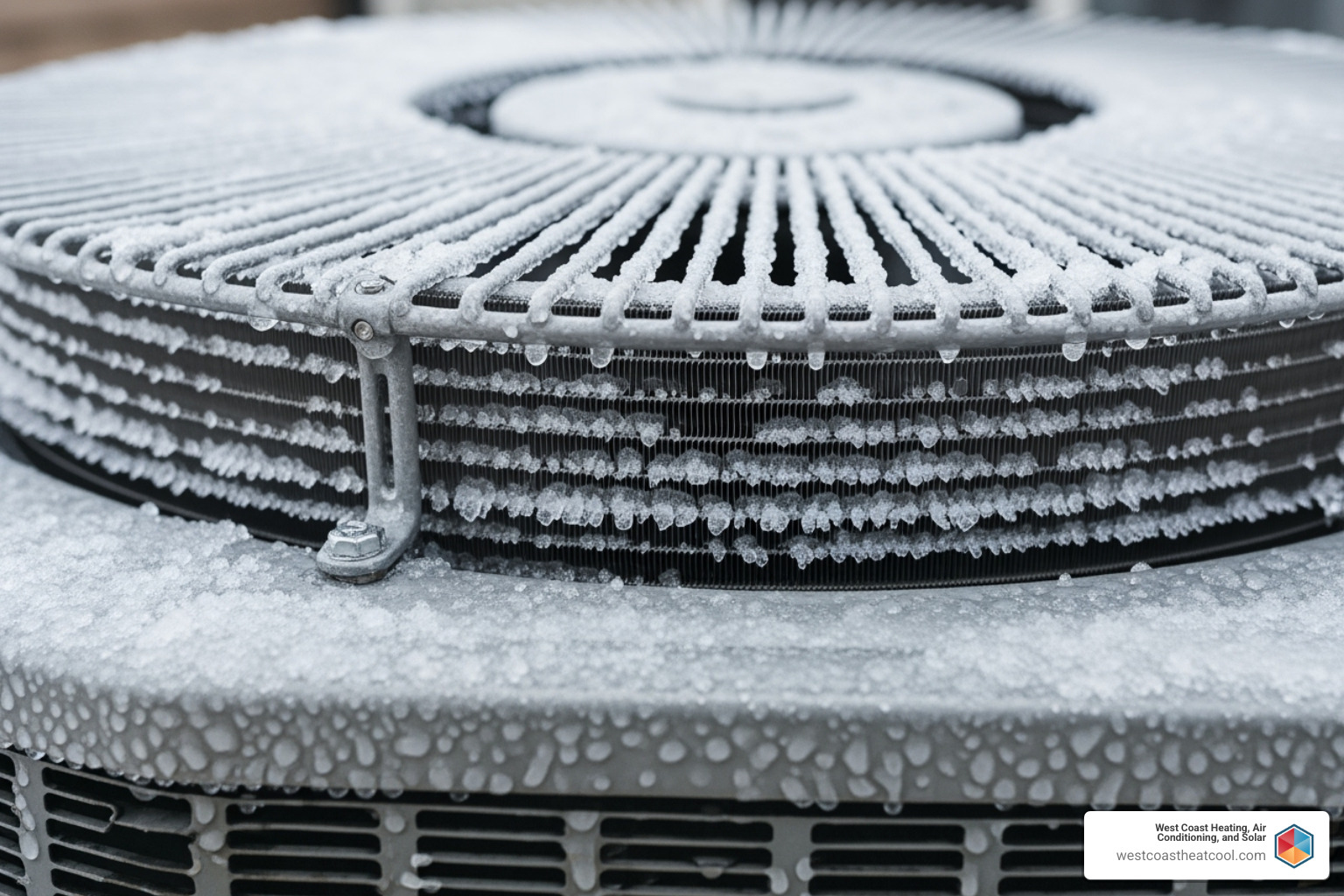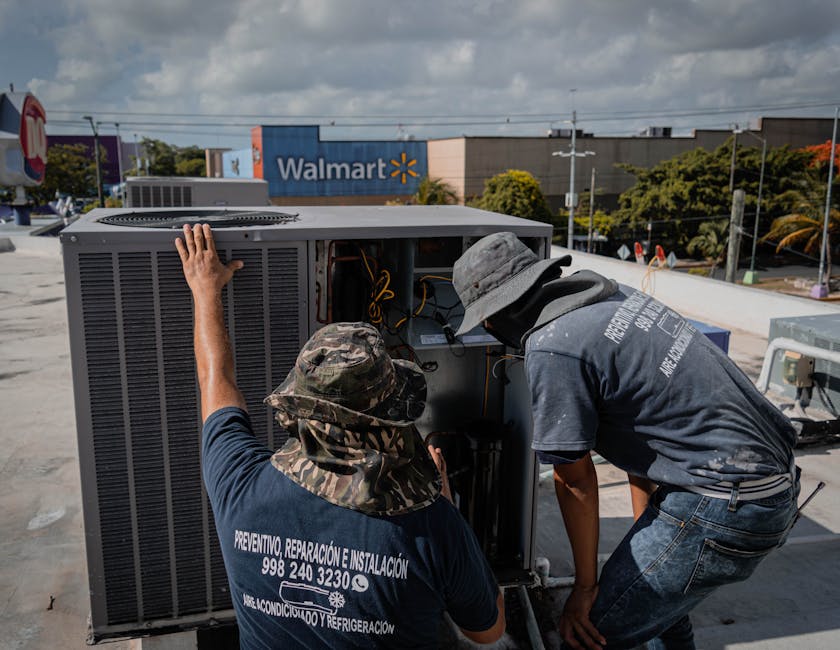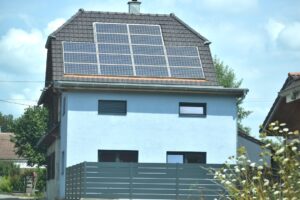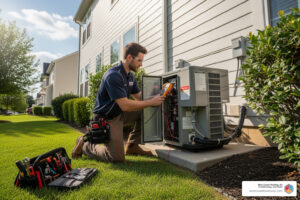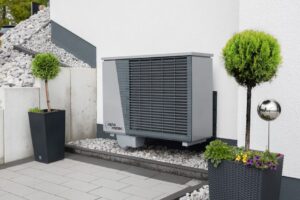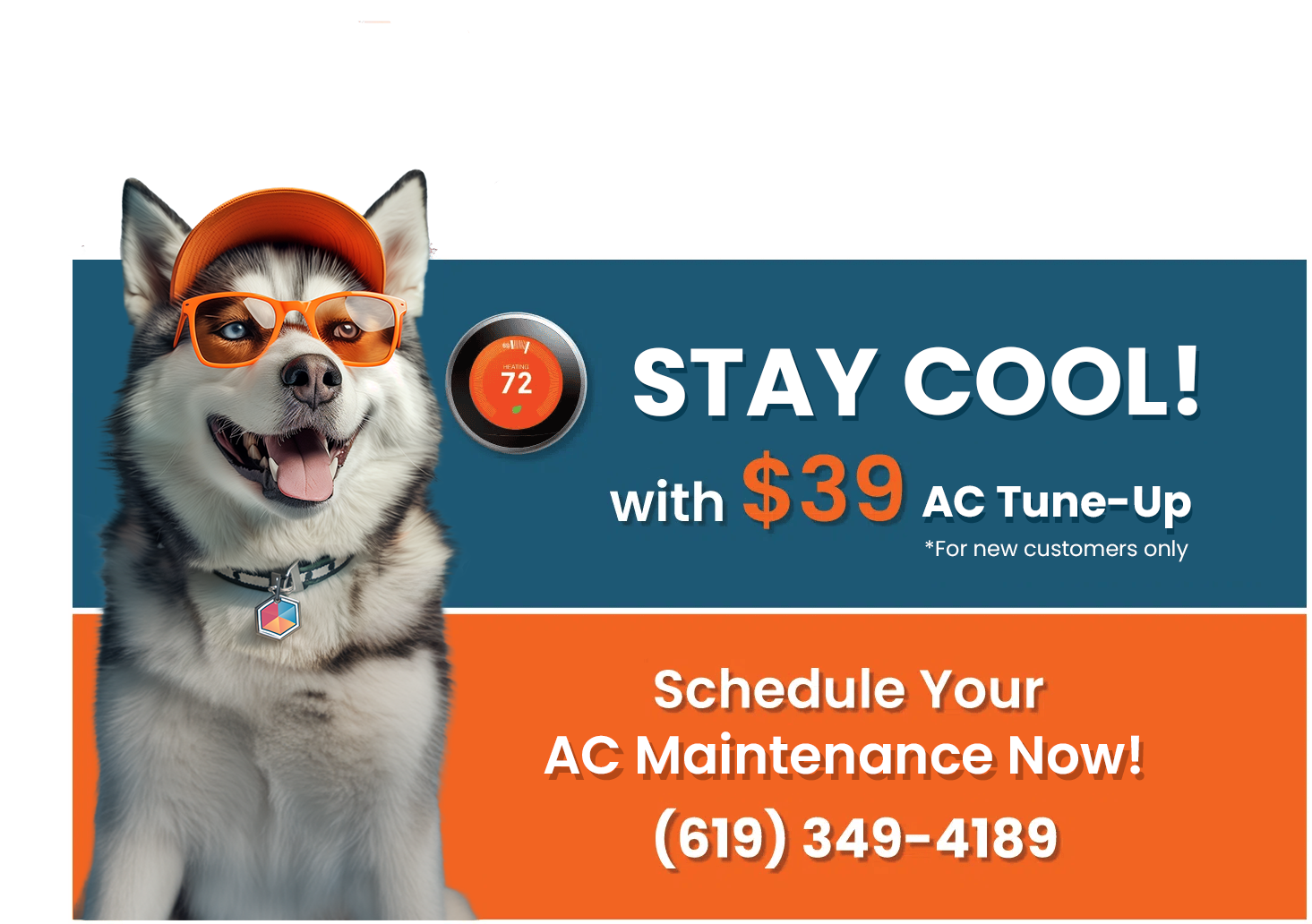Why Air Conditioning Problems Strike When You Need Cool Air Most
Air conditioning problems always seem to happen at the worst possible times – right when San Diego’s summer heat kicks in. Few things are more frustrating than your AC blowing warm air or refusing to turn on during a heat wave.
Most common AC problems and quick fixes:
- AC won’t turn on – Check thermostat settings, replace batteries, reset tripped circuit breaker
- Not blowing cold air – Replace dirty air filter, check for blocked vents, inspect for refrigerant leaks
- Unit freezing up – Turn off system, check air filter, ensure proper airflow, let ice thaw completely
- Strange noises – Grinding (motor issues), squealing (belt problems), banging (loose parts), hissing (refrigerant leak)
- Water leaking – Clear clogged condensate drain line, check drain pan, turn off unit immediately
Here’s the good news: many AC issues can be solved with simple troubleshooting before calling a professional. Dirty air filters cause up to 15% higher energy bills and can freeze your evaporator coil. Blocked vents require 25% more energy to distribute air properly.
But some problems – like refrigerant leaks, electrical failures, or compressor damage – need expert attention. A hissing sound often means a refrigerant leak that harms the environment and kills your cooling power. Grinding noises usually signal expensive motor problems.
The key is knowing which fixes you can handle safely and when to call in the pros. Let’s walk through the most common AC problems, what causes them, and how to get your system running smoothly again.
Initial DIY Troubleshooting: Simple Fixes to Try First
When your AC stops working on a hot San Diego afternoon, don’t panic just yet. Many air conditioning problems have surprisingly simple solutions that won’t require a service call. Think of this as your detective work – sometimes the culprit is hiding in plain sight.
Why Won’t My AC Turn On? Power and Thermostat Checks
Nothing’s more frustrating than hitting the thermostat and getting… nothing. Before you assume the worst, let’s play detective with the most common causes.
Start with your thermostat – it’s the brain of your cooling system. Check that it’s set to “Cool” mode rather than “Heat” or “Fan Only.” Make sure the temperature setting is actually lower than your current room temperature. It sounds obvious, but you’d be surprised how often someone accidentally bumps the settings.
Dead thermostat batteries are sneaky troublemakers. If your thermostat display looks dim or blank, pop in fresh batteries. Many homeowners forget that most thermostats need battery power to communicate with the AC unit.
Next, head to your electrical panel. Your AC has its own circuit breaker, and if it tripped, your unit won’t get power. Look for a breaker that’s flipped to the “off” position or sitting in the middle. Flip it firmly to “off,” then back to “on.”
Here’s an important safety note: if the breaker trips again immediately, stop. This signals a serious electrical problem that needs professional attention. Electrical issues can be dangerous, so don’t keep resetting a breaker that won’t stay on.
For more detailed troubleshooting steps, check out our guide on Fixing an AC That Won’t Turn On.
The Critical Role of a Clean Air Filter
Your air filter might look simple, but it’s one of the hardest-working parts of your AC system. When it gets clogged with dust, pet hair, and debris, it becomes a major source of air conditioning problems.
A dirty filter is like trying to breathe through a pillow – your AC just can’t get enough air. This creates a domino effect of issues. Your system works harder but cools less effectively, leaving you with lukewarm air from the vents and an AC that runs constantly without reaching your set temperature.
The energy costs add up fast too. A clogged filter can spike your energy bills by up to 15% because your system is working overtime to pull air through that dirty barrier.
Even worse, restricted airflow can freeze your evaporator coil. When warm air can’t reach the coil properly, moisture freezes on it, turning your AC into an expensive ice maker. We’ll talk more about frozen coils later, but know that a dirty filter is often the root cause.
Check your filter monthly during cooling season – it’s that important. If it looks gray and clogged instead of white or light-colored, it’s time for a replacement. Our article on How Often Do You Change Your Air Filters? has all the details on timing and filter types.
Clearing the Way: Vents and Outdoor Unit Obstructions
Your AC needs clear pathways to move air effectively. When these get blocked, you’re fighting an uphill battle against air conditioning problems.
Indoor vents get blocked more often than you’d think. That couch you moved last month might be covering a return vent. Curtains, furniture, or even a strategically placed houseplant can block airflow and force your system to work 25% harder. Walk through your home and make sure all supply and return vents are clear and open.
Your outdoor condenser unit needs breathing room too. This hardworking component expels all the heat from your home, but it can’t do its job when surrounded by leaves, grass clippings, or overgrown shrubs.
Take a walk outside and check your unit. Clear away any debris and trim back vegetation to give it at least two feet of clearance on all sides. Think of it as giving your AC room to breathe – because that’s exactly what it needs to keep you cool.
For a deeper dive into keeping your vents clean and clear, our guide on How to Clean AC Vents walks you through the process step by step.
Common Air Conditioning Problems and Their Symptoms
After you’ve tackled the basic troubleshooting steps, you might find your AC has more complex issues. These air conditioning problems often announce themselves with telltale symptoms that can help you understand what’s going wrong under the hood.
Don’t worry – recognizing these signs early can save you from bigger headaches down the road. Let’s walk through the most common culprits and what they’re trying to tell you.
AC Not Blowing Cold Air: The Refrigerant Leak Riddle
There’s nothing quite like the sinking feeling when your AC is humming along, sounding perfectly normal, but pumping out air that’s about as cool as a lukewarm cup of coffee. This frustrating scenario often points to a refrigerant leak.
Think of refrigerant as your AC’s lifeblood. It’s the special chemical that absorbs heat from inside your home and carries it outside. Unlike the gas in your car, refrigerant doesn’t get consumed – it circulates endlessly in a sealed system. So when levels drop, you’ve got a leak somewhere.
Warm air from vents is the most obvious red flag, but other signs include hissing or bubbling sounds coming from your unit. That hissing is literally the sound of refrigerant escaping through a crack or hole. You might also notice ice forming on your evaporator coil – counterintuitive, but low refrigerant actually causes freezing.
Your energy bills might spike too. When refrigerant levels are low, your AC runs constantly trying to reach the temperature you’ve set, but never quite getting there. It’s like trying to fill a bucket with a hole in the bottom.
Here’s something many homeowners don’t realize: refrigerant leaks harm the environment. These chemicals are potent greenhouse gases, so fixing leaks quickly helps both your wallet and the planet. For an overview of refrigerant environmental impacts and regulations, see the EPA’s guide to Refrigerant Management.
Our detailed guide on What Causes AC Refrigerant Leaks explains more about identifying and addressing these issues.
Refrigerant work requires special tools and certification, so this is definitely a job for the pros. Adding more refrigerant without fixing the leak is like putting a band-aid on a broken pipe – it might work temporarily, but you’ll be back to square one soon enough.
Why Is My AC Unit a Block of Ice?
Walking outside to find your AC unit looking like it belongs in Antarctica can be pretty alarming. But a frozen AC is actually your system’s way of waving a white flag, signaling that something else has gone wrong.
The most common culprit? That dirty air filter we talked about earlier. When airflow gets restricted, warm indoor air can’t reach the evaporator coil. Without that warm air, the moisture on the coil drops below freezing and turns into a solid block of ice.
Low refrigerant levels can also cause freezing. When refrigerant is low, the pressure in your system drops, making the evaporator coil get extremely cold. Other airflow problems like blocked vents or issues with your blower motor can create the same icy result.
If you find your unit frozen solid, resist the urge to grab an ice scraper. Turn off your AC immediately and let nature take its course. Depending on how much ice has built up, thawing can take anywhere from a couple hours to a full day. You can run just the fan to help speed things along, but never try to chip away the ice – you could damage the delicate coils.
Once everything’s thawed, address the root cause. Change that filter, clear those vents, or give us a call if you suspect a refrigerant issue. For more specific information about why this happens in our San Diego climate, check out our article on What Causes Frozen AC Units in San Diego, CA.
Decoding Your AC’s Strange Noises
Your AC unit has its own language, and most of the time it speaks in a gentle, consistent hum. But when it starts making sounds like a dying robot or an angry bear, it’s time to pay attention.
Grinding sounds are perhaps the most serious. This harsh, metal-on-metal noise usually means motor bearings are failing in either your outdoor fan or indoor blower. Think of it as your AC crying out in pain – turn it off immediately before the motor seizes completely. Our guide on AC is Making Grinding Sounds can help you understand what’s happening.
Squealing or screeching often points to worn belts or failing motor bearings. It’s like fingernails on a chalkboard, and your AC is just as uncomfortable as you are hearing it.
Banging or clanking suggests something has come loose inside your unit. Maybe a fan blade is hitting something, or internal components are rattling around where they shouldn’t be. Either way, it’s time to call in the cavalry.
Clicking sounds are trickier – occasional clicks when your system starts up are normal. But continuous clicking might indicate thermostat problems or failing electrical components.
Buzzing noises typically signal electrical issues like loose wires or failing capacitors. This is especially concerning because electrical problems can be dangerous. Our article on AC Making Buzzing Noise dives deeper into these electrical gremlins.
Hissing sound we mentioned earlier? That’s often your refrigerant making its escape, while bubbling might indicate excess moisture where it doesn’t belong.
When your AC starts speaking in strange tongues, especially with grinding, screeching, or banging, give it a rest and call us. Your ears (and your system) will thank you.
Puddles and Smells: Solving Drainage Problems
Nobody wants to find mysterious puddles around their AC or catch a whiff of something that smells like a musty basement. These air conditioning problems are your system’s way of telling you its drainage system needs attention.
Your AC is constantly pulling moisture out of the air – that’s part of how it cools your home. All that water needs somewhere to go, and when the drainage system gets clogged, things get messy fast.
Water leaking indoors usually means your condensate drain line is blocked. Over time, dust mixes with moisture to create a slimy buildup that can completely clog the drain. When water can’t escape, it backs up and overflows, potentially causing serious damage to your home. If you spot water where it shouldn’t be, turn off your AC immediately to prevent costly water damage.
Musty odors are often the calling card of mold and mildew growing in that stagnant water. As air flows over these unwelcome guests, it picks up their unpleasant smell and spreads it throughout your home. Not exactly the fresh, cool air you were hoping for.
Sometimes you can clear minor clogs yourself with a wet/dry vacuum or a vinegar solution, but stubborn blockages or suspected mold growth call for professional help. Our comprehensive guide on Solving AC Drain Line Clogs walks you through both DIY solutions and when to call in reinforcements.
Don’t ignore drainage issues – they can lead to expensive water damage and poor indoor air quality. Your family’s health and your home’s integrity are worth addressing these problems quickly.
When to Call a Pro: Serious Mechanical and Electrical Failures
Here’s where things get serious. While we love empowering homeowners with DIY fixes, some air conditioning problems involve components that are frankly too dangerous or complex to tackle yourself. Think of it this way: you might change your car’s oil, but you probably wouldn’t rebuild the engine in your driveway.
The same logic applies to your AC system. When mechanical or electrical failures occur, attempting repairs can put you at risk, damage expensive components, or void your warranty. Let’s explore the warning signs that it’s time to call in the cavalry.
Signs of a Failing Compressor or Fan Motor
Your AC’s compressor is like the heart of the system – it pumps refrigerant through the entire cycle. The fan motors, both inside and outside your home, are the lungs that keep air moving. When either of these critical components starts failing, you’ll know it.
The outdoor fan not spinning is often the first sign of trouble. You might notice your condenser unit sitting quietly while the indoor unit hums along, but no cold air comes out. Sometimes the fan blades will turn slowly or not at all, even though you can hear the unit trying to work.
Overheating becomes a major concern when fans fail. Without proper airflow, your outdoor unit can get dangerously hot, triggering safety shutdowns. This protection mechanism prevents catastrophic damage, but it also means no cooling for your home.
Grinding or squealing sounds from either unit often signal motor bearings wearing out. Unlike the occasional startup noise, these sounds are persistent and get worse over time. If you hear them, turn off your system immediately – continuing to run a failing motor can cause complete failure and much higher repair costs.
A system that won’t start at all might indicate compressor failure or a seized motor. You might hear electrical humming without any actual cooling happening. This could point to a failing start capacitor, which gives motors the electrical boost they need to get going.
Compressors typically last 8-10 years with proper maintenance, but when they fail, replacement can be costly. That’s why prevention is so important – our guide on Prevent AC Compressor Failure shows you how to extend your compressor’s life. If you’re dealing with a fan that’s not working, our article AC Fan Isn’t Working can help you understand what’s happening.
The Hidden Dangers of Electrical and Sensor Issues
Electrical problems are the sneaky villains of air conditioning problems. Unlike a noisy fan motor or visible ice buildup, electrical issues often hide behind seemingly random symptoms that can drive homeowners crazy.
Capacitor failure is surprisingly common and can cause bizarre behavior. These small cylindrical components store electrical energy to help motors start and run smoothly. When they fail, your outdoor fan might not spin, your compressor might struggle to start, or your entire system might cycle on and off rapidly.
Corroded wiring and loose connections create intermittent problems that can be maddening to diagnose. Your AC might work perfectly one day, then fail the next. These issues often worsen over time and can create fire hazards if left unchecked.
Short cycling – when your AC turns on and off every few minutes instead of running steady cycles – puts enormous stress on your compressor. While dirty filters can cause this, electrical problems and faulty sensors are often the real culprits.
Sensor malfunctions can make your system behave erratically. If your thermostat sensor is out of position or failing, your AC might run constantly, never reach the set temperature, or shut off too early. These problems waste energy and leave you uncomfortable.
Circuit breaker tripping is your electrical system’s way of saying “something’s wrong!” If your AC keeps tripping the breaker, never just keep resetting it. This is a serious safety issue that requires professional diagnosis. Our article on AC Circuit Breaker Tripping explains the potential causes and dangers.
Similarly, when your thermostat stops responding or gives inaccurate readings, the problem might go deeper than dead batteries. Complex wiring issues or internal component failures need professional attention. Check out our guide on AC Thermostat Stops Working for more insights.
The bottom line? Electrical and mechanical failures aren’t just inconvenient – they can be dangerous. When you encounter these issues, calling a certified HVAC technician isn’t just the smart choice, it’s the safe one.
The Big Picture: Maintenance, Repair, or Replacement?
Understanding common air conditioning problems is one thing, but knowing when to invest in a repair versus considering a full replacement is a different ball game entirely. This decision can feel overwhelming, especially when you’re dealing with a broken AC in the middle of summer heat. The truth is, this choice depends on several key factors: the age of your unit, the cost of the repair, and its overall efficiency.
Think of it like owning an older car. At some point, you have to weigh whether it makes more sense to keep putting money into repairs or invest in something newer and more reliable. Your AC system follows the same logic.
The Power of Prevention: How Regular Maintenance Stops Problems
Here’s something that might surprise you: many common air conditioning problems can be completely prevented with proper, regular maintenance. Think of it like changing the oil in your car – it keeps everything running smoothly and extends its lifespan significantly.
Preventing breakdowns is the biggest benefit of routine maintenance. When our certified technicians perform regular tune-ups, we can catch minor issues before they escalate into major, costly repairs. We’ll identify worn parts, clean dirty coils, check refrigerant levels, and spot potential problems that could leave you sweating later.
Improving efficiency is another major advantage. A well-maintained AC unit operates more efficiently, meaning it uses less energy to cool your home. This translates directly into lower energy bills for you – sometimes saving hundreds of dollars per year.
Extending lifespan might be the most valuable benefit of all. While a typical residential air conditioner lasts 10-20 years, consistent maintenance can help it reach the higher end of that range, or even longer. We’ve seen well-maintained units in San Diego County run efficiently for over two decades.
We also ensure your refrigerant charge matches the manufacturer’s specifications. Incorrect refrigerant levels can seriously impair your AC’s efficiency and lead to costly repairs down the road.
We recommend scheduling professional AC maintenance at least once a year, ideally in the spring before the peak cooling season hits here in San Diego County. This ensures your unit is ready for the summer heat. Our comprehensive AC maintenance services in San Diego, CA are designed to keep your system in top shape. You can learn more about how Springtime Air Conditioner Maintenance Ensures Cool Summer Comfort in our detailed guide.
Making the Call: Repairing vs. Replacing Your AC
Deciding whether to repair or replace your AC unit is a significant financial decision that affects your family’s comfort and your budget. Here’s how we help our customers in areas like Carlsbad, Encinitas, and Escondido make the best choice for their situation.
| Factor | Repair | Replace |
|---|---|---|
| Age of Unit | If your AC is less than 10 years old and has been well-maintained, repair is usually the smart choice. Newer units are designed to last and often just need minor fixes. | If your AC is 10-15 years old or older, consider replacing it. Older units are less efficient, more prone to breakdowns, and may use outdated R-22 refrigerant that’s being phased out. |
| Repair Cost | If the repair cost is less than 50% of the cost of a new unit, especially for younger units, repair is often the more cost-efficient and eco-friendly option. | When repair costs exceed 50% of replacement cost, or when you’re facing major component failures like compressor or heat exchanger issues, replacement usually makes more financial sense. |
| R-22 Refrigerant | If your unit uses newer refrigerants and the repair is straightforward, fixing it is typically worthwhile. | Units using R-22 refrigerant (being phased out) face expensive refrigerant costs and limited availability. Replacement with a modern system is often the better long-term investment. |
| Energy Star Rating | Newer, efficient units that need minor repairs are worth maintaining to keep enjoying their energy savings. | Older units with low efficiency ratings cost significantly more to operate. Upgrading to an Energy Star rated system can cut your cooling costs by 15-20% or more. |
The decision becomes clearer when you consider the total cost of ownership. An older unit might seem cheaper to repair now, but if it’s going to need another expensive fix in six months, replacement starts looking much more attractive.
Our team can help you weigh these factors honestly. We’re not here to sell you something you don’t need – we want to help you make the smartest decision for your family and budget. For more detailed guidance on this important decision, check out our comprehensive article on Replace vs. Repair Aging AC System.
If replacement is the right choice for you, our AC replacement services in San Diego, CA ensure you get a properly sized, efficiently installed system that will serve your family for years to come.

